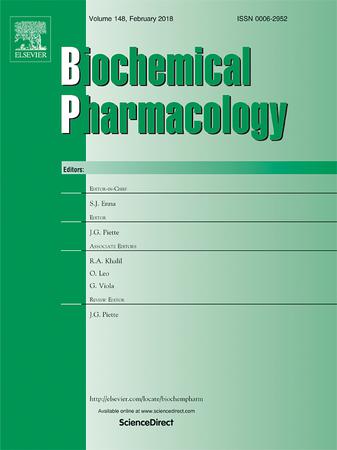Small-molecule inhibitor BAY synergizes with gemcitabine through AHR inhibition in pancreatic cancer cells
IF 5.3
2区 医学
Q1 PHARMACOLOGY & PHARMACY
引用次数: 0
Abstract
Pancreatic cancer (PC) presents a significant challenge in treatment efficacy due to late-stage diagnosis and chemoresistance. The effects of the combination of a selective small-molecule AHR inhibitor and gemcitabine treatment effectiveness in PC cells has been a focus of research. This study utilized the PC cell lines BxPC-3 and Su.86.86 to investigate the impact of AHR activity modulation on gene and protein expression related to the gemcitabine response. Assays including viability measurement, combinational index calculation, qRT–PCR, Western blot analysis, immunocytofluorescence, and clonogenic assays, were employed. Additionally, patient tissue samples were analysed for AHR, ELAVL1, and DCK levels. The results show that AHR activity modulation influenced ELAVL1 localization, DCK expression, and gemcitabine response. Inhibition of AHR activity caused synergistic effects with gemcitabine, whereas activation had an antagonistic effect. Regarding colony formation, inhibition of AHR increased gemcitabine effectiveness by 30–41%, whereas activation decreased the response by 11–28%. Patient tissue analysis revealed correlations between AHR, ELAVL1, and DCK mRNA levels and showed increased levels of AHR protein (2.2-fold) and decreased DCK protein levels (36% decrease) in tumor tissue compared to next-to-cancer tissue. These findings demonstrate the potential of AHR modulation to improve gemcitabine treatment outcomes. This study highlights the significance of AHR modulation in influencing the gemcitabine response in PC cells. By inhibiting AHR activity, cells exhibited improved gemcitabine response, offering a promising avenue for enhancing treatment efficacy. These findings suggest that AHR could serve as a target for optimizing gemcitabine treatment and potentially reducing cancer aggressiveness.

求助全文
约1分钟内获得全文
求助全文
来源期刊

Biochemical pharmacology
医学-药学
CiteScore
10.30
自引率
1.70%
发文量
420
审稿时长
17 days
期刊介绍:
Biochemical Pharmacology publishes original research findings, Commentaries and review articles related to the elucidation of cellular and tissue function(s) at the biochemical and molecular levels, the modification of cellular phenotype(s) by genetic, transcriptional/translational or drug/compound-induced modifications, as well as the pharmacodynamics and pharmacokinetics of xenobiotics and drugs, the latter including both small molecules and biologics.
The journal''s target audience includes scientists engaged in the identification and study of the mechanisms of action of xenobiotics, biologics and drugs and in the drug discovery and development process.
All areas of cellular biology and cellular, tissue/organ and whole animal pharmacology fall within the scope of the journal. Drug classes covered include anti-infectives, anti-inflammatory agents, chemotherapeutics, cardiovascular, endocrinological, immunological, metabolic, neurological and psychiatric drugs, as well as research on drug metabolism and kinetics. While medicinal chemistry is a topic of complimentary interest, manuscripts in this area must contain sufficient biological data to characterize pharmacologically the compounds reported. Submissions describing work focused predominately on chemical synthesis and molecular modeling will not be considered for review.
While particular emphasis is placed on reporting the results of molecular and biochemical studies, research involving the use of tissue and animal models of human pathophysiology and toxicology is of interest to the extent that it helps define drug mechanisms of action, safety and efficacy.
 求助内容:
求助内容: 应助结果提醒方式:
应助结果提醒方式:


